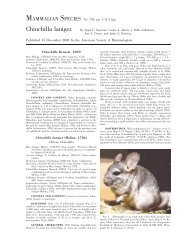Brugia Malayi - Clark Science Center - Smith College
Brugia Malayi - Clark Science Center - Smith College
Brugia Malayi - Clark Science Center - Smith College
You also want an ePaper? Increase the reach of your titles
YUMPU automatically turns print PDFs into web optimized ePapers that Google loves.
Impact of the Oxidized Guanine Lesion Spiroiminodihydantoin on the<br />
Thermodynamic Stability of DNA<br />
Hanyu Shi<br />
The oxidation of DNA bases has been found to be a potential factor in Alzheimer’s, cancer, cellular aging and other neurological<br />
disorders. 1 Guanine is the most easily oxidized of the four standard DNA bases because of its reduction potential and can be<br />
oxidized to form 7,8-dihydro-8-oxo-2’-deoxyguanine (8-oxoG). Further studies show that the 8-oxoG may be further oxidized by<br />
reactive oxygen and nitrogen species as well as high-valent metals, 2 such as Cr(VI) and Ir(IV), to form spiroiminodihydantoin (Sp)<br />
lesion. The chiral carbon at the spiro center of the Sp lesion creates R and S enantiomers that become a pair of diastereomers<br />
when bonded to the furanose ring DNA. This stereochemistry gives the lesion a unique structure that has the potential to greatly<br />
impact the stability and biological processing of DNA. Although the Sp lesion has been studied in nucleosides, nucleotides and in<br />
vitro systems, little is known about the role of the Sp lesion in complex biological systems.<br />
My project is a collaborative study between Professor Jamieson and Mount Holyoke <strong>College</strong> Professor, Megan Núñez to study<br />
DNA damage in complex biological systems. The project explores and examines whether Sp lesion site-specifically introduced<br />
into a DNA olignucleotide construct will thermodynamically change the formation of nucleosomes. The question we ask is what<br />
effect the Sp lesion will have on the affinity of histones for DNA, and whether the lesion will change the rotational phasing of the<br />
nucleosome on the DNA. Two 20-mer oligonucleotide sequences containing 8-oxo-G (one at 7 position and one at 12 position)<br />
were ordered from TriLink BioTechnologies. The Sp lesion was synthesized by reacting sodiumchlorideiridate(IV) (Na 2<br />
IrCl 4<br />
)<br />
with the 8-oxo-G oligonucleotides. The Sp lesion generates two diastereomers, which were purified and collected by HPLC, then<br />
confirmed by Mass Spectroscopy.<br />
Further studies have already commenced. The confirmed diastereomers of the Sp lesion were sent over to Mount Holyoke<br />
<strong>College</strong>. Students in the Núñez work on synthesizing and assembling the Sp-containing DNA oligonucleotide constructs. The<br />
final Sp-lesion duplexes will be gel purified and radioactively labeled. The relative binding affinity of the histones for the DNA will<br />
be determined by gel shift assay, revealing whether the Sp lesions facilitate or hinder nucleosome formation. (Supported by the<br />
National Institutes of Health)<br />
Advisor: Elizabeth Jamieson<br />
References:<br />
1<br />
Chinyengetere, F., Jamieson, E.R., Thermodynamic Impact of the Sp lesion, Biochemistry 2008, 47, 2584-2591.<br />
2<br />
Sugden, K. D., Campo, C. K., and Martin, B. D. (2001) Direct oxidation of guanine and 7,8-dihydro-8-oxoguanine in DNA by a high-valent chromium complex:<br />
a possible mechanism for chromate genotoxicity, Chem. Res. Toxicol. 14, 1315-1322.<br />
2012<br />
84

















